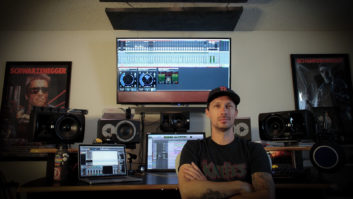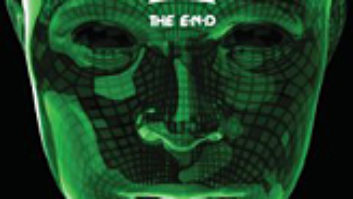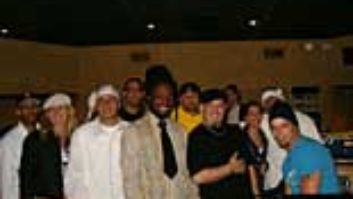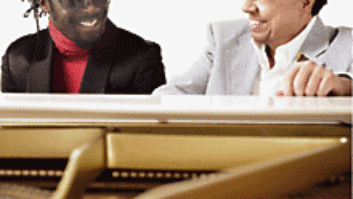
The Black Eyed Peas strut their stuff while onstage (L-R): apl.de.ap, Fergie, will.i.am and Taboo
Photo: Steve Jennings
To paraphrase the opening of their infectious song “Let’s Get Retarded,” L.A.’s Black Eyed Peas “keep runnin’, runnin’, runnin’, runnin’…” They’ve toured virtually nonstop for the past couple of years, methodically building a large, multiracial following for their funky, eclectic, good-vibes hip hop. So it’s not too surprising that the only time I can get group mastermind/lead rapper/producer will.i.am (Will Adams) on the phone, he’s in a limo on the way to a gig at The Joint in Las Vegas’ Hard Rock Hotel. I can’t tell if it’s his band or posse sharing the car with him, but whoever they are, they’re loud, and our conversation is punctuated with will.i.am’s asides to them, asking questions like, “Hey, how do we get to the dressing room?” “It’s a little crazy in here,” he says apologetically. And after seeing the band tear up the Warfield Theater in San Francisco two nights later with one of the most mesmerizing, kinetic and uplifting shows I’ve seen in years, I can well imagine that a wild scene probably follows this group everywhere. You can double that on a Friday night in Vegas.
I’ll confess up front that I’m not somebody who’s been diggin’ the Peas for years. Truth be told, like a lot of people, I came in with “Where Is the Love,” their socially conscious, Grammy™-nominated single. Now that I know how great this band is, however, I wish that I’d been around 15 years ago in L.A. when will.i.am and his Filipino schoolmate apl.de.ap (Allen Pineda) were break dancing and rapping their way to forming a group called the Atban Klann. Later, they added a Mexican American rapper who goes by the name Taboo (Jaime Gomez) and became the Black Eyed Peas, part of the progressive, non-gangsta wing of rap/hip hop from the lineage of great groups like De La Soul, A Tribe Called Quest, Digable Planets and various others. With nods to Latin music, jazz, ’70s funk, rock and anything else that struck them, Black Eyed Peas distinguished themselves not just for the fast-rapping and dance moves of their three MCs, but because they fronted a real band, still a relative rarity in the hip hop world. They were signed by Interscope, put out their first album, Behind the Front, in mid-1998 and immediately hit the road, playing anywhere and everywhere they could — but, ironically, not that many hip hop clubs, because most could not accommodate a full band. By the time of their second album, the 2000 Bridging the Gap, word was definitely starting to get around about the Peas and their great live performances. They earned spots on a succession of big tours — traveling festivals like Smokin’ Grooves and the Vans Warped Tour, and opening for the likes of OutKast, Macy Gray (who appeared on Bridging the Gap) and No Doubt.
But it’s been their third, and most recent, album — Elephunk, released in the summer of 2003 — that has launched the band into the stratosphere, with more than a million albums sold in the U.S. alone (compared to just over 200,000 for Bridging the Gap, according to Nielsen SoundScan), propelled by “Where Is the Love,” featuring guest artist Justin Timberlake. Another song from the album, “Hey Mama,” with its infectious mixture of dance hall riddims’ and rhymin’ and the hypnotic wailing of the newest member of the BEPs — the gorgeous lithe siren, Stacy Ferguson (aka Fergie) — has been making waves on radio and on MTV. And there seems to be no end to the potential hits from this exceptional disc: their hard-rocking collaboration with Papa Roach (they were on the Warped tour together) called “Anxiety”; will.i.am and Fergie’s verbal joust, “Shut Up”; the smooth, pleasant groove of “Latin Girls”; the group’s exultant anthem, “Hands Up” (which contains the horn vamp from an old Yma Sumac record!); and funkiest of all, “Let’s Get Retarded,” which has recently been re-tooled as the more PC “Let’s Get It Started.” You’ve got to love an album that features Sergio Mendes playing piano on one song, another that boasts a chorus sung in Tagalog (apl.de.ap’s native tongue) and all sorts of old analog synths (will.i.am’s great love) and even a guitarron.
“We don’t put any boundaries on our music,” will.i.am says, “and that may be one reason people all over the world like the Black Eyed Peas.” He’s not bragging, exactly, just stating the facts: “We’re triple-Platinum in Switzerland, Sweden, Germany, the UK, Australia, New Zealand, Canada, Singapore. We’ve played Japan, Vietnam — we were the first group to play there since Joan Baez in 1972. That was incredible, man! It’s been a whirlwind.”
will.i.am produced or co-produced all of the tracks on Elephunk (the name, he says, is “to conjure a big, deep funk sound”) and he even did a fair amount of engineering on the disc, much of which was recorded at his own studio known as The Stewchia in the Los Feliz section of L.A. A fine keyboardist and drummer, will.i.am has picked up his engineering and production chops by osmosis, working on the three BEP albums and a pair of solo “soundtracks.” (More on that in a minute.) “I wouldn’t say I’m naturally technical,” he offers, “but I’ve always been interested, you know what I mean? I’ve had a whole bunch of people helping me in the studio: Dave Pensado taught me a lot of stuff. Rhett Lawrence is the one that taught me Pro Tools. Dylan Dresdow taught me a lot of problem-solving on Pro Tools — he was Dave Pensado’s assistant and now he does a lot of the engineering for us. Tony Maserati did a lot of the mixes on the [latest] album and he’s taught me a lot, too. He’s great! So I’ve been taught by some of the best.”
Like so many current artists, will.i.am is a total devotee of Pro Tools. “I do everything in Pro Tools now,” he says. “I used to program my drums on the Akai MPC 3000, but now I just do it in Pro Tools.” His studio is based around “a full-blown Pro Tools|HD rig. I’ve got the Mac G5 with the new [Pro Tools] 6.1 system, and I’ve still got the old [OS] 9.0 system with the slot cards. I’ve gotta have both. I like the new and I like the old.” He also has the ProControl 24, “but I’m interested in getting that new Pro Tools console [the ICON] I’ve been hearing about. That’s gonna change the world!
“I hate it when someone runs the Pro Tools and it’s slow,” he adds with a laugh. “I gotta get behind the controls. I like to do the recording and punching in, editing, cleaning up, doing the rough mix. I like to make a reference mix for Tony Maserati. Then he comes in and he’ll do his thing, cleaning up the frequencies and working on this part or that part, to where it can play on every radio and CD and Walkman and car.”
Black Eyed Peas songs have sprung from many different sources: sequenced parts, samples, drum loops, even real instruments on occasion. “It depends,” will.i.am says. “A lot of times, what I’ll do is I’ll have a mic and I’ll play a beat with my hands on a table and get a tempo. I’ll loop that, make a grid on Pro Tools and then start importing sounds. I’ll put a kick wherever the kick should go, a snare wherever that lands. Then I’ll go in and put a hi-hat over that programmed beat that was derived from me playing drums on the table. The thing about a real drum kit, though, is that it’s the sound traveling from here to there — it’s air moving. So what I sometimes do is turn up my system really loud, put a record on the turntable and then record the turntable in a stereo track onto Pro Tools. The vibration from the speakers hits the needle of the turntable and I get the vibration of the kick and the snare through the needle. I’ll record that and put it into [Line 6] Amp Farm to give it distortion and then it sounds like a real drum kit. I like messing around with stuff like that.”
will.i.am is also an aficionado of vintage keyboards, a big part of the Peas’ sound: “There was a point in time when I collected Moogs and clavinets and old synthesizers and Wurlitzers, Rhodes, Hammond organs, those little old Yamaha portable acoustic piano things — whatever I could find. But after I found the sounds I liked and was comfortable with, I stopped getting new ones. The Moog is fine, the clav is fine, the clav with the Rhodes is fine; I’ve got my clusterf***. I’ve messed with some digital synths, too. I’ve used the [Korg] Triton a bit, but that sound is out there too much — it seems like every song’s got it, and I like the older analog sounds better for what I do.”
Elephunk was a long time in the making, will.i.am says. “First we went out to a house in Bodega Bay [north of San Francisco] and recorded a whole bunch of songs. Our last day up there was September 11 [2001], and then we had to go on tour September 12. That was a weird time, as you can imagine. Then, right after the tour was over in October, we went into my studio and recorded some more. Then from there, I thought, ‘I don’t really know how to produce my own vocals,’ so we went into Glenwood [Place Studios, Burbank, Calif.] to record the vocals there. After that, we waited a while, the record company digested the songs and they weren’t really that excited with them. We were like, ‘Whaaat?’ We already had ‘Where Is the Love,’ ‘Shut Up’ and some others. So at that point, I went back to my studio and recorded a whole bunch of new songs. This time, though, I decided to try doing the vocals there, so I put a Neumann mic right next to my Pro Tools rig and my keyboard and I recorded my vocals myself. So I adopted a routine: I don’t write any of my lyrics down anymore; I just record them straight onto Pro Tools myself. I don’t even need a second engineer.”
It must be noted, however, that Black Eyed Peas albums are extremely collaborative affairs. Most songs have multiple writers, with apl.de.ap and Taboo often contributing their own raps, of course, but also lots of input from guitarists J. Curtis and George Pajon Jr. (who tears it up as part of the live band, too), bassist Mike Fratantuno, keyboardist/arranger Printz Board and others. Mixer Pensado had a big footprint on the first two albums and to a lesser degree on Elephunk. This time around, Maserati was the primary mixer.
Maserati says that he was such a fan of the band that he sought them out to work on Elephunk, traveling from New York to L.A.’s Record Plant, carrying his own Pro Tools rig and mixing on Studio 3’s SSL 9000 J through Tannoy DMT and ProAc Studio 100 monitors. He recalls, “I would spend six to eight hours going through the sounds and then will.i.am would come in and he would feed off what I was doing and do a bunch of edits, maybe change an arrangement part here and there, and then I’d work on it some more. Most of the songs took a day-and-a-half to two days to mix.”
“I would always do a mix internally [in Pro Tools] before I’d hand it over to Tony,” will.i.am adds. “Most of the sounds are developed during the writing process and then I put in what I’m looking for using plug-ins. Tony then would either keep the sound I had from the plug-in or change it by using outboard gear: ‘Will, do you really want this much compression on the kick?’ So he’ll fix it if I’ve got it wrong.”
“One of the things I love about Will,” Maserati elaborates, “is he knows what he wants, which is always the sign of a good producer. But he’s also willing to try other things. I’ll always respect what he’s got in his head. So we’ll go back and forth between the sound that he was using and one I might come up with; see which one works better. That was a lot of fun because Will likes to experiment. He’s not locked into an idea just because it’s his idea.”
And will.i.am is fairly brimming with ideas. He’s also put out two albums under his own name in recent years: Lost Change is the soundtrack for an Internet-only film and features a blend of hip hop tunes and diverse instrumental pieces; and Must B 21 was created for an ad campaign for Coors’ Zima beverage and includes collaborations with KRS-One, Planet Asia, Johnny Legend and others. “I did Lost Change in two weeks and Must B 21 in a week,” he comments. “There’s something to be said for a project that you don’t put too much thought behind — you just get your ideas down quickly and work on them when they’re fresh.”
More recently, will.i.am contributed a track to the Dirty Dancing: Havana Nights soundtrack and did a couple of remixes (with Maserati) for Sting. He’s started his own clothing line — i.am — which will no doubt reflect his eclectic fashion taste: At the Warfield concert, he was dressed in baggy layers, with a vest and striped shirts and a Rasta cap over his dreads — sort of an Abercrombie & Marley effect. He’s cutting a “hip hop bossa nova” album with Mendes (“I used to sample his Brasil ’66 albums when I was starting out 10 years ago,” will.i.am says) and is deep in the planning for the next Black Eyed Peas disc, which he hopes will be out in the late fall.
It will once again be a highly diverse affair, capitalizing on the band’s and rappers’ development during the past year of touring, the further integration of Fergie (who joined toward the end of making Elephunk) and will.i.am’s maturation as a producer. “The driving instrument I’m thinking of using is an accordion,” he muses as he wanders toward his dressing room at The Joint, cell phone in hand. “Accordions, oboes, trombones — it’s gonna be different. Instead of a Rhodes, I want to have an accordion.” Why accordion? “Italy, man. I’ve been traveling the world a lot and there’s something about an accordion that gives you a sense of traveling. We’ve been traveling around the world on this Elephunk thing and now I want that story to be told.”





